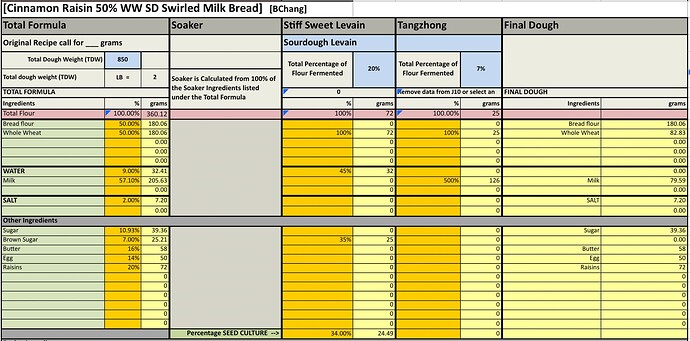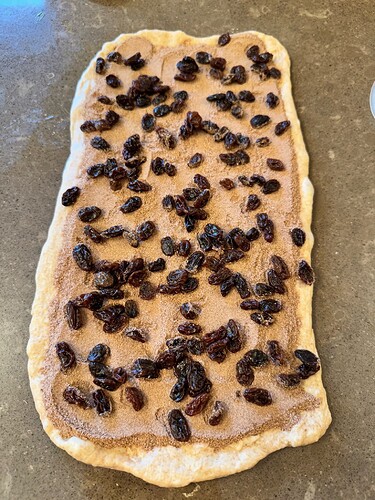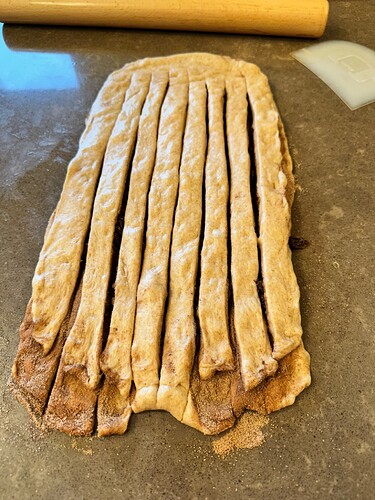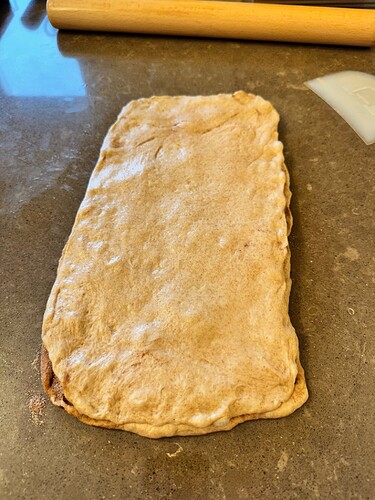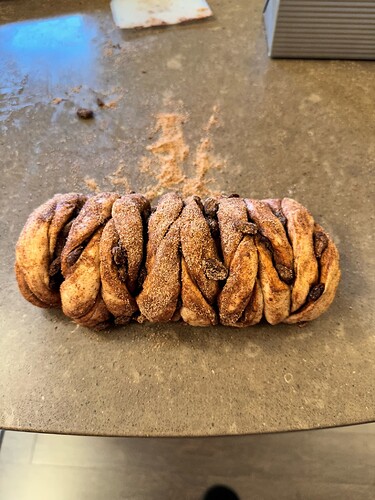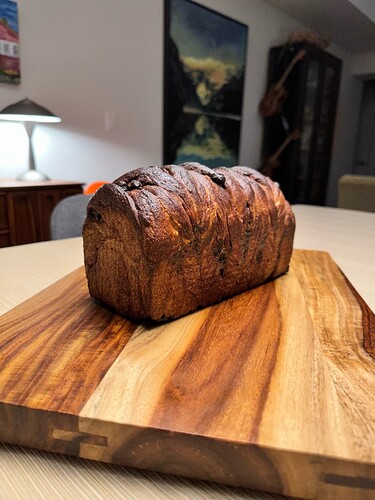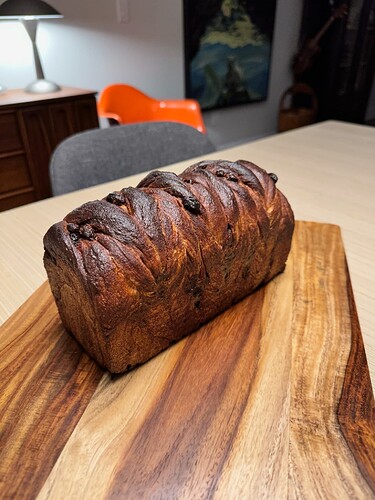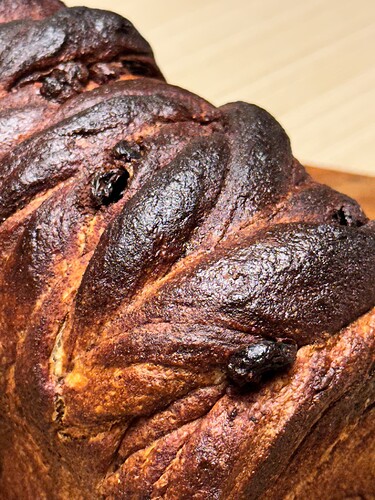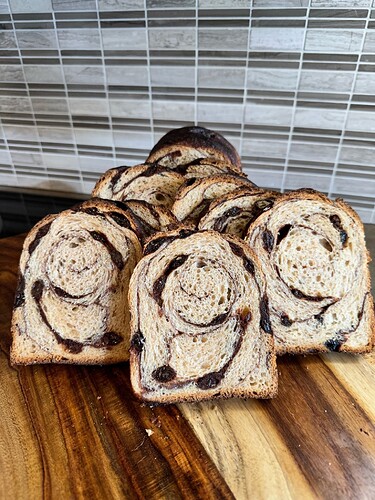I needed more bread now that I’ve returned to Toronto. Despite making 24 rolls there were none left after Christmas dinner! I wanted to do the braiding again like the loaf I gave to an friend and show that it doesn’t have to have a pinched waist. After baking this loaf, which admittedly is a bit darker than even I like because of the cinnamon sugar getting on the outside of the dough, I believe that my oven in Fort Lauderdale is running a bit low in temperature. I’ll have to get an oven thermometer to check on it when I return. This bake was also a test of my starter to see if it is up to snuff. I’d say that it could still use a couple more feeds before I bake with it again.
For one 9x4x4” Pullman pan
Instructions
Levain
Mix the levain ingredients in a jar or pyrex container with space for at least 300% growth.
Press down with your knuckles or silicone spatula to create a uniform surface and to push out air.
At a temperature of 76-78ºF, it typically takes up to 10-12 hours for this sweet stiff levain to be at peak. For my starter I typically see 3-3.5 times increase in size at peak. The levain will smell sweet with only a mild tang.
Tangzhong
In a sauce pan set on medium heat, stir the milk and Whole wheat flour until blended. Then cook for several minutes until well thickened, stirring regularly with a spoon or heat-resistant spatula. Let cool in the pan or, for faster results, in a new bowl. Theoretically it should reach 65ºC (149ºF) but I don’t find I need to measure the temperature as the tangzhong gelatinizes at this temperature. You can prepare this the night before and refrigerate it, ensure that it is covered to prevent it from drying out.
If you plan on using a stand mixer to mix this dough, set up a Bain Marie and use your stand mixer’s bowl to prepare the tangzhong.
Raisins
Place the raisins in a microwave safe bowl, spritz with water, cover with cling wrap and then microwave at 10 second intervals until the raisins are rehydrated. Alternatively, soak in water overnight. In the morning, strain and pat dry before use.
Cinnamon filling
12 g cinnamon
30 g white sugar
7.5 g all purpose or bread flour
Combine cinnamon and sugar and flour and set aside.
Dough
In the bowl of a stand mixer, add the milk (consider holding back 10 g of milk and adding later if this is the first time you’re making this), egg, tangzhong, salt, sugar and levain. Mix and then break up the levain into many smaller pieces. Next add the flours. I like to use my spatula to mix until there aren’t many dry areas. Allow the flour to hydrate (fermentolyse) for 20-30 minutes. Mix on low speed and then medium speed until moderate gluten development this may take 5-10 mins. You may want to scrape the sides of the bowl during the first 5 minutes of mixing. Next add room temperature butter one pat at a time. The dough may come apart, be patient, continue to mix until it comes together before adding in more butter. Once all the butter has been added and incorporated increase the speed gradually to medium. Mix at medium speed until the gluten is well developed, approximately 10 mins. You will want to check gluten development by windowpane during this time and stop mixing when you get a good windowpane.
On the counter, shape the dough into a tight ball, cover in the bowl and ferment for 4 hours at 82ºF. There should be some rise visible at this stage.
You can next place the dough into the fridge to chill the dough for about 1.5 hours, this makes rolling the dough easier to shape. Remember, if you do so the final proof will take longer. Alternatively, you can do a cold retard in the fridge overnight, however, you may find that this increases the tang in your bread.
Prepare your pan by greasing them with butter or line with parchment paper.
Divide the dough into 2 equal portions. Form each into tight boules. Stretch and then roll each piece of dough into a large rectangle, approximately equal sizes. Spread the cinnamon sugar evenly over one of of the rectangles of dough leaving about 1cm at the edge of dough without mashed potato. Lightly sprinkle some flour onto the cinnamon sugar, this will help absorb some of the water that the sugar draws out of the dough. Spread the prepared raisins next. Place the other rectangle of dough onto the other sandwiching the sweet potato between them. Using a rolling pin, roll the dough out a bit more aiming for more than 12” in length and just under 9” in width.
Using a ruler and pizza cutter, cut the dough into evenly wide strips about 1.5-2 cm wide along the length of the dough but leaving about 2-4 cm of dough uncut at the end furthest away from you. When all the strips are cut, twist the strips in alternating directions, clockwise and then counter clockwise. Once all the strips are twisted, roll the whole thing into a log starting furthest away from you getting a nice tight roll at the start. Transfer the dough into your prepared pullman pan with the seam side down.
Place in the buttered baking pan seam side down.
Cover and let proof for 4-6 hours at a warm temperature. I proof at 82°F. You will need longer than 4-6 hours if you chilled your dough for shaping. I proof until the top of the dough comes to within 1 cm of the top edge of the pan.
Preheat the oven to 350F and brush the dough with the egg-milk wash. Just prior to baking brush with the egg-milk wash again.
Bake the loaves for 50 minutes or until the internal temperature is at least 190ºF, rotating as needed to get even browning. Shield your loaf if it gets brown early in the baking process. After 50 mins remove the bread from the pan and bake a further 10 mins by placing the loaf directly in the oven on the rack with the oven turned down to 325ºF. You can brush the top of the loaf with butter if you wish at this point while the bread is still hot to keep the top crust soft.
No pinched waist, so I think that my Florida oven needs an oven thermometer and that the pinched waist of that loaf was caused by it baking too low a temperature.

